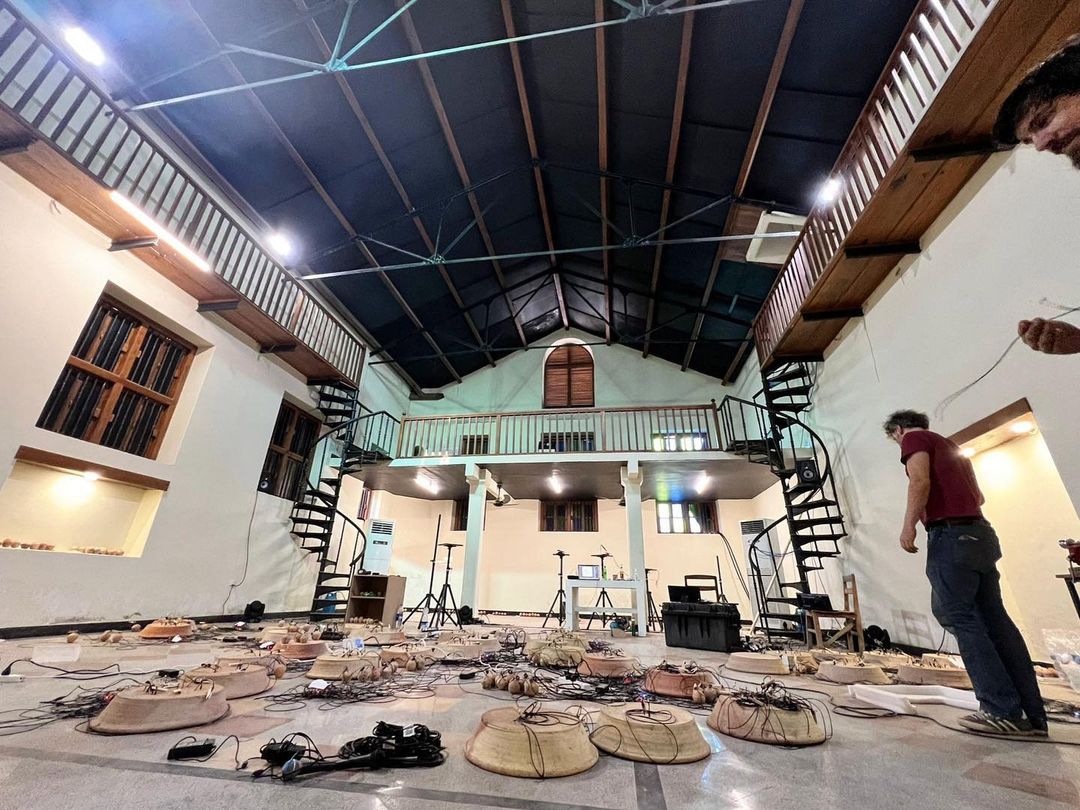When most people think of technology, a 5000 year-old instrument is perhaps the last thing that comes to mind. Yet, the borindo, an instrument which
When most people think of technology, a 5000 year-old instrument is perhaps the last thing that comes to mind. Yet, the borindo, an instrument which has miraculously escaped cultural extinction, is at the centre of the Karachi Biennale’s (KB22) Jury Prize winning tech-based installation. Located at the NED University (City Campus), the work “Microtonal” – the brainchild of the UK based art collective Invisible Flock – takes the form of an interactive, data-driven sound sculpture created from around 200 borindos made by Allah Jurrio and Faqir Zulfiqar. The latter is a Sindhi folk musician and one of the few remaining practitioners of the 5000 year-old instrument the borindo. Resembling a latoo (spinning top) in appearance, this completely clay crafted instrument almost acts like a spherical harmonica, producing a range of sounds when the musician blows into one of its many holes.

According to Zulfiqar, “I have heard this musical instrument was found in Mohenjo-Daro. A similar instrument is called ocarina in Japan. The hole-shaped pattern of the borindo is also reminiscent of the nests small insects make.” Jurrio, a 90-year-old potter from Badin, has also played an integral part in ensuring that this simplistic yet intriguing piece of Sindh’s musical history did not fade away with time. “Allah Jurrio crafts the vessel on the wheel. Then I make the holes to tune it according to scale,” Zulfiqar stated. Jurrio has been a borindo craftsman for more than 25 years, having learned his craft at a very young age. “Clay pots are not difficult to make because they are large. This instrument is difficult because it is very small. You have to shape the cavity accurately. No one except me knows how to craft this instrument,” he said. Funnily enough, this collaboration between a musician and potter from Badin and a group of artists from the UK seems inevitable and logical once you understand the philosophy which drives Zulfiqar. As he put it, “Artists and musicians are not defined by boundaries. They belong to no country or race. They are free souls around the world. But we are restricted by the norms of our society.”

All this begs the question as to how and why a UK based group of artists decided to collaborate with Jurrio and Zulfiqar to tell the tale of a near-forgotten instrument. Ben Eaton is the technical director of Invisible Flock, and he told me that their discovery of the borindo was rather serendipitous. “We were actually watching Indus Blues, the documentary film by Jawad Sharif, and that’s where we first saw the borindo. It captured our imagination, and now here we are!” Eaton, a digital artist and creative technologist in his own right, was cheerfully answering questions from inquisitive visitors outside the “Microtonal” exhibit when I met him on 30th November. A day earlier he had been on stage at the opening ceremony of KB22 receiving the Jury Prize alongside Zulfiqar and Jurrio.

Eaton is interested in the creative use of new technology, place, hardware and sound – and “Microtonal” was certainly a testament to that. Through sound, the work uses the deep cultural and personal history these individuals share with this novel musical instrument to explore the encoded symbolism held within it. This display is a continuation of Invisible Flock’s sense-based installations, many of which operate at the intersection of art and the environment.

Their work on display at the NED University attempts to strip audiences of their sense of sight, hence prompting the auditory experience to take centre stage. Viewers, or rather listeners, enter a dark space humming with the unmistakable sound of borindos. Like a perpetual echo, the symphony of borindos fills the air, jumping from one borindo to the next, each fitted with a little microphone. As the music reverberates across the room through the speakers, one can’t help but be entranced by the musical and visual splendour of the 200 borindos.

Collaborating with people like Zulfiqar and Jurrio is a core tenet of Invisible Flock. As the group puts it, “Our aim is to open up critically important ways of thinking about how we live, how we connect and share to live better together in a global society. To achieve this we believe that art must be made alongside a broad range of different people. We strive to work with those people living at the forefront of our world’s greatest issues. We dedicate our time to exploring this most important issue of our time and how digital art practices can offer new perspectives and practical solutions and engage with those often excluded from these conversations. The medium of technology has always been the best way for us to articulate new questions and generate alternative understandings of complex systems. As we find ourselves in a reality where digital is present in everything, we believe challenging, manipulating and playing with this reality allows us the agency to look at the world we live in from different perspectives.”

Suffice it to say that their immersive sound installation at KB22 is one of the highlights of this year’s biennale, as is the opportunity to view, listen to and marvel at the work of Jurrio and Zulfiqar.

COMMENTS